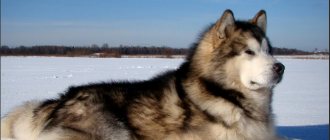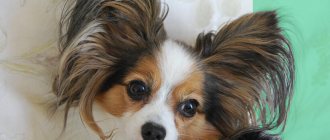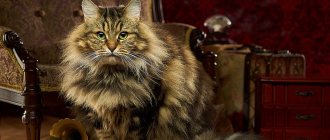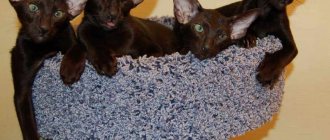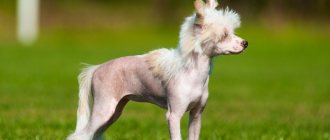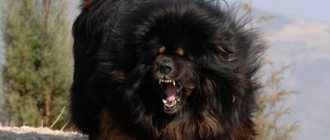The Papillon is a small, beautiful dog with a recognizable appearance. Because of its widely spaced ears, covered with long, hanging hair, the breed was called the “butterfly”. Papillons are cheerful, sociable and intelligent. This is not just a lap dog that will lie on the sofa, but an ideal companion that strives to follow its owner everywhere. This is one of the most popular decorative breeds. But before getting a Papillon, you need to study the description of these dogs, their characteristics, pros and cons, and reviews from owners.
- Head
- Features of education
- Health
History of the origin of the breed
The Papillon dog breed is often called the French Papillon, and because of the similarity of their ears to the wings of an elegant insect - butterflies and Papillon moths. This decorative feature became the main reason for further improving the breed and giving it a modern look.
The first written mention of small dogs with erect fluffy ears, similar to butterflies, is about 800 years old. At that time, Papillons were called Continental Toy Spaniels. In a very short time the breed received its current name. At the same time, phalenas were identified, the difference of which was not erect, but hanging ears.
It was impossible to determine the exact time of the birth of the breed. Experts identify 2 most likely versions.
According to the first of them, papillons appeared in the 11th century. This can be evidenced by the fact that Duke Gottfried from Lower Lorraine, during the crusade, brought with him to Jerusalem an unusual dwarf dog with fluffy erect ears, reminiscent of the open wings of a butterfly.
According to the second version, the breed in a form close to the modern one appeared only in the 14th century; and dogs similar in appearance to them, which were known earlier, are their ancestors.
Butterflies belong to the royal dogs. It is believed that the King of France, Henry III, was so captivated by the appearance of the Papillons that he spent a significant part of his treasury on their purchase and maintenance. However, there is no official confirmation of this.
There is also a legend that one of Henry III’s favorites tried to warn him that a monk who came to the king was planning an assassination attempt. The dog began to bark so loudly at the guest that it had to be taken to another room. Her behavior was not understood, and the assassination attempt was carried out.
The French monarchs Louis X1V, Louis XV and Louis XVI also turned out to be big fans of Papillons. Marie Antoinette and the Marquise de Pompadour were also not indifferent to the breed. Thanks to this, butterfly dogs became extremely fashionable among the nobility, which had a positive effect on the improvement of their decorative appearance. For a long time, Papillons were called “the lap dog of queens and kings.” Owners took animals with them to receptions and balls, and exquisite pets were often depicted in portraits.
At the end of the 19th century, the breed was brought to America, and from the 20th century, British dog breeders became interested in Papillons and began work on improving the dog’s appearance to bring it to the ideal. For this purpose, the Papillon was crossed with the Spitz. This mixture had a positive effect on the breed: its coat became fluffier and longer, and its tail took on a more striking position. Official breed standards have been approved since 1934, and today Papillon dogs are bred whose description meets these requirements.
General characteristics of the Papillon breed
The Papillon is a small toy breed of dog whose beautiful ears resemble butterfly wings. They are widely spaced and covered with long hair. This is why the breed received its name, since papillon is translated from French as “butterfly”. Experts call her a continental toy spaniel, and amateurs call her a “daddy.” Less popular is another variety of the breed - Phalene - with hanging ears.
Papillons love their owners very much, they are loyal and affectionate. They need attention and care and are very sensitive. This is a cheerful and good-natured companion, but always ready to bravely rush to protect his family members. The Papillon is smart, curious and active. Capable of learning tricks, suitable for agility. The breed ranks 8th in the ranking of the smartest dogs.
| Options | Characteristic |
| breed name | continental toy spaniel, papillon or papillon |
| country of origin | France |
| group of breeds according to the ICF classification | decorative dogs |
| height | 20-28 cm |
| weight | 3-5 kg |
| life expectancy | 13-15 years old |
| purpose | companion |
| peculiarities | smart, sociable, active, cheerful |
| aggressiveness | sometimes aggressive, may bite |
| activity | high |
| intelligence | very smart, easy to train |
| attitude towards a person | friendly, loyal, do not tolerate loneliness well |
| care | complex grooming |
| health | good |
pros
The Papillon is a small dog with an attractive appearance and a sociable, cheerful character. It is popular among lovers of decorative breeds and ranks first in intelligence. This is explained by many advantages:
- very smart, quick-witted;
- inquisitive, loves to learn new things, can learn different tricks;
- loyal, accompanies the owner everywhere;
- kind and affectionate;
- easily adaptable, you can take it with you on a trip;
- friendly, loves to play with children;
- cheerful, cheerful;
- does not spoil furniture, does not chew things;
- gets along easily with other pets, except rodents;
- clean, no dog smell.
Minuses
Most of the shortcomings of these dogs are the same as those of other breeds of a similar size. This is a fragile physique, a ringing voice and the possibility of aggression. Papillons also have other disadvantages:
- very active, energetic, love to run;
- you need to carefully select your diet, otherwise you will gain weight;
- may bite painfully;
- requires careful grooming;
- In winter they need clothing and get cold quickly.
This interesting video explains in more detail the pros and cons of the Papillon breed:
Video: Papillon pros and cons of the breed
Description of the breed with photos
All characteristics of the breed are established by the current standard. The main distinguishing features of the appearance of the dogs are the abundant pubescence of the ears and tail and the intense shine and special thickness of the coat. The description of the dog looks very attractive.
Appearance
American standards divide butterfly dogs into Papillons and Phalenes, but regard them as one breed. In Europe, breeders consider these criteria to be incorrect. In their opinion, these are two completely different breeds, although they have certain similarities. The statement is justified by the fact that when mating Papillons and Phalenes, the offspring have pronounced defects in appearance. Such dogs do not meet the standards and are not allowed for exhibitions.
Outwardly, an inexperienced dog breeder may confuse the butterfly with long-haired Chihuahuas and Spitz dogs. The Papillon is a spaniel of luxurious appearance, reduced to miniature.
- Head. Proportional to the body, with a fairly convex forehead, along which runs a shallow furrow. The skull is longer than the muzzle, rounded. The transition from the forehead to the muzzle is somewhat smoothed out in large individuals, while in small ones it is distinct.
- Nose. Black, round, with a medium-sized lobe and a flat back.
- Teeth. Located close to each other, completely covering the tongue. If it extends beyond the jaw, then this is a serious deviation from the standards, due to which the animal is not allowed to exhibit.
- Eyes. They are almond-shaped and large. Their convexity is moderate. Eye set is low. The eyelids are brightly pigmented. The iris is dark.
- Ears. The ear funnel is held in a straightened position by cartilage. It is subtle yet strong. The tip of the ear is rounded, but not too rounded. The stance is relatively high on the Phalene and high on the Papillon. When the dog is in a calm state, the ears are raised and their insides are open. The long outer coat is fringed, completely covering the edge of the ear. On the inner surface the hairs are curly and thin. They are allowed to extend beyond the funnel. At birth, Papillons have drooping ears, and they stand up between 2 and 4 months.
- Neck. Length is average. The scruff is slightly arched.
- Body (body). The line of the back is smooth, without sharp dips or bulges. The chest is wide, with arched ribs. The abdomen and groin area are moderately tucked.
- Paws. Medium length, smooth, graceful. Shoulders of normal development, close to the body. Elongated blades. The angle of the shoulder and hock joints is normal. Elongated foot. The fingers are strong, have a hard and tough black pad, and dark claws. It is considered acceptable for white dogs to have milky white claws. There is often hair between the toes.
- Tail. It has a high seat and a flowing dewlap, reaching up to 15 cm. When the dog moves, the tail is located along the top line of the back or touches it at the end. A distinctive characteristic of purebred dogs is that the tail never lies on the back or curls into a donut.
General appearance standards are accepted for Papillons of any color. Deviation from the standards leads to the culling of the individual and its exclusion from exhibitions. Breeding dogs with visual flaws is highly discouraged.
Size and weight
The breed is classified as small. The height of the dog at the withers should not exceed 28 cm . The weight of Papillons is from 2.5 to 5 kg . There are also periodically encountered individuals that can be classified as mini. Their weight is no more than 2 kg 400 g, height up to 25 cm .
Important! Its small size and attractive appearance make the butterfly dog look like a toy. However, you should remember that the pet is fragile and requires careful handling.
Color and coat type
The coat is medium soft, long with a silky sheen and wavy. There is practically no undercoat. The characteristics of the coat are similar to those of the Cavalier King Charles Spaniel. Short hair is found only on the muzzle, the outside of the front legs and the metatarsals. There is considerable length of hair on the body. Feathers are present on the inside of the front legs, ears, and thighs. There is a pronounced fluffy collar on the neck.
According to FCI standards, the breed is allowed any color with a pronounced, predominant white background on the body and legs. The predominant colors are white and black, white and sable and tricolor. Sable color has two options - muted and rich, which is also called red sable.
Three-color coat color is also available in two variants. In the first case, the black and white Papillon has small red markings in the area of the eyes, ears and cheeks, which makes the dog especially attractive. In the second, which is called the hound, the areas of red fur are large, and white patches are allowed on the head.
Breed variety
Papillons are a type of spaniel that also includes Phalenes, which are also recognized by American breeders as representatives of the breed, but only with slightly different standards of appearance. The size of Phalenes and general appearance are similar to Papillons, but their ears are floppy. The name of the dog is translated from Belgian as “moth”. The remaining characteristics of Papillons and Phalenes are similar.
Distinctive features
A truly royal dog with graceful movements and a slightly arrogant appearance. Papillons are distinguished by their elongated body format, pointed muzzle, long hair and small size. As a rule, both males and females reach 28 cm , but they weigh differently: from 1.5 kg to 5 kg.
The standard distinguishes between two types of Continental Spaniels: Papillon (butterfly ears - erect) and Phalene (dropping ears). In all other respects, both subspecies are almost the same. However, crossing them is prohibited because the puppies end up with semi-erect ears.
- The head is small, light, but proportional to the body. The skull is not too round, the furrow between the eyes is visible. Stop is expressed.
- The muzzle is short, narrowed, the bridge of the nose is straight. Cheekbones are filled, cheeks are flat. The jaws are strong with a scissor bite. Thin lips pressed to the jaws.
- The nose is small and round.
- The eyes are large, almond-shaped; set low and wide. The inner corner of the eye is in line with the stop. The color is dark brown, the eyelid is pigmented.
- Ears . Papillon : ears stand on hard cartilage, set high, rounded at the tips, set at 45° to the horizon, covered with thick flowing hair. Phalene : Ears are set high, drooping and close to the head, surrounded by thick, flowing hair.
- The body is more elongated than square. The topline is straight, the back is strong and short. The loin is rounded, the croup is not sloping. The chest is wide and deep with rounded ribs. The belly is well tucked. The neck is curved, of medium length.
- The tail is high set, quite long, carried over the hip or lower back, but does not form a ring. Surrounded by long hair that forms a fountain.
- The limbs are set parallel and straight. Quite strong and muscular. The paws are long, like a hare's. The fingers are well developed and mobile. The movements are graceful, proud, light.
- The coat is wavy, thin, flowing and shiny. Quite thick, no undercoat. The hair is short on the body and head, frilled on the neck, and elongated on the ears and tail. Feathering on the limbs is characteristic.
- The color is white with spots of any color. The head should always be dark.
Health and illness
The breed is quite healthy, as it is a small, but not miniature, dog. Up to 13 years of age, dogs can remain vigorous and active, without obvious signs of old age. There are few specific diseases to which butterflies are prone. The most common pathologies are the eyes. Your pet may have cataracts, entropion, or corneal dystrophy.
The small size of the animal makes it quite fragile, and therefore luxation of the kneecap, which in veterinary medicine is called patella, can occur. This phenomenon usually appears due to injury, when the animal jumps from a great height, or from an unsuccessful fall, when a dog that loves to run finds itself on a slippery surface and cannot fit into a turn.
A disease that is specific to Papillons is congenital deafness. There is no cure for it, and therefore, when purchasing a puppy with this problem, you should understand that the dog will not outgrow it with age.
The breed has not been found to be prone to cancer, heart or joint pathologies. Also, when properly maintained, butterflies do not become obese. Feeding disorders, like all breeds, can provoke pathologies of the liver and pancreas in Papillons, but this already refers to the general problem of improper maintenance, which is dangerous for any dog.
Like all small breeds, Papillons are susceptible to viral diseases, which is why it is important for them to strictly follow the vaccination schedule. The absence of undercoat makes the animal more susceptible to cold, so when walking in winter, if they are long, the pet must be dressed.
How long do Papillons live?
The average lifespan of Papillons is about 15 years . If all recommendations are strictly followed when keeping a dog, the animal does not suffer from infectious diseases, and the area in which it lives is environmentally friendly, then the pet can celebrate its 20th birthday. There are not many such long-livers, but they do exist, and the owner should strive to maximize the life of the Papillon.
Key points in training
Papillons are one of the most intelligent breeds and are easy to train and suitable for beginners. But often such spaniels try to dominate and show character, so the owner should show the puppy who is boss in the house. This can be done without brute force or punishment, for example, the main method is feeding after all family members and prohibiting free movement on furniture. The dog must know its place in the house and in the family hierarchy, respecting all members of the household.
Read about how to properly train a dog in the article: “Training a puppy: effective methods from dog handlers, learning commands at home.”
Continental Toy Spaniel puppies are smart and curious, so they quickly learn names and commands. They also sense the owner’s mood and try not to upset him. From 4 months, when the dog already knows the daily routine and nickname well, you can learn the commands “Near”, “Place”, “Sit”, “No” . Papillons show good results in agility (obstacle course).
Character and intelligence
The breed is one of those positive pets that rarely have a bad mood. The dog is characterized by curiosity, activity and joyful behavior. Even a small thing can cause significant interest in a Papillon, and he will be busy studying a new subject for a long time. During walks, the animal shows curiosity and strives to explore every corner, which is why, when passing where there may be objects dangerous to the animal, it is better to take the pet in your arms. Papillons, who have an affectionate character, will only be happy about this.
Papillons are distinguished by their devotion to their owner. Because of this, being alone for a long time is very stressful for an animal. In order not to expose your pet to unnecessary psychological trauma, it is recommended to have it in a family where there is always someone at home, or to purchase two dogs at once. A pet that is satisfied with the company of its own kind will not suffer in the absence of a person.
By the way! By getting two puppies from one litter, the new owner minimizes stress for the kids, since he does not completely tear the dog out of his usual circle. This has a beneficial effect on the animal's mental health.
The nervous system of representatives of the Papillon butterfly breed is sensitive. They tolerate rough treatment and psychological pressure extremely poorly. These mistakes when communicating with a pet can easily cause the animal to develop inappropriate behavior and mental disorders.
The breed's intellectual abilities are high. Dogs easily learn new skills and quickly begin to understand frequently repeated words. The Papillon does not need to give strict commands. A pet living in a family quickly guesses what they want from him, simply by listening to ordinary speech. This behavior of an animal to people who have no experience with dogs may seem something completely unusual and exceptional.
Butterflies that are distinguished by their activity sometimes seek solitude. Such a drastic change in character can be provoked by two reasons: illness or the fact that the animal does not like someone in the company and does not want to communicate with him. If a Papillon remains passive for more than a day, it should definitely be shown to a veterinarian.
Attitude towards children and others
Dogs usually quickly find a common language with younger family members and become friends, but only if the children do not offend them. If a child causes pain or other unpleasant sensations to the dog, then it can stand up for itself by using its teeth. Therefore, parents should teach their child the right attitude towards a dog from an early age, explaining that this is not a toy, but a living creature with its own rights and desires. Dogs of this breed are very pleasant to talk to both children and elderly people.
Papillons are usually friendly towards strangers, but without being intrusive. They will not run to meet passers-by, but they will willingly play with guests if they show such a desire. A properly raised pet will not impose its society.
Papillons are friendly towards other animals and willingly communicate with them. They can easily make friends with cats and large dogs, and when living in rural areas, with yard dwellers such as goats and piglets, if they are not aggressive and have access to them. Smart and cheerful butterflies are usually the first to organize games and make contact.
Breed traits
Breed traits (on a 5-point scale)
| Papillon | |||
| Activity | in the house | 1.8 | |
| on the street | 2.7 | ||
| Obedience | training | 4.5 | |
| strangers | 3 | ||
| Domination | in family | 1.5 | |
| over dogs | 1 | ||
| Defending your territory | from people | 1 | |
| from dogs | 1 | ||
| Sociability | in family | 5 | |
| with strangers | 3 | ||
| with dogs | 3 | ||
| Concentration | in family | 1 | |
| in front of strangers | 3 | ||
| with dogs | 2 | ||
| Aggressiveness | in family | 2.5 | |
| to strangers | 3.8 | ||
| to the dogs | 3 | ||
| to cats | 2 | ||
| Family behavior | calmness | 4.8 | |
| demand for affection | 5 | ||
| excitability | 2.6 | ||
| playfulness | 3 | ||
| excessive barking | 2 | ||
| behavioral breakdowns | 1.8 | ||
| Tolerance for children | up to 4 years | 4.7 | |
| over 4 years old | 4.8 | ||
| Institutional use | watchman | 1.2 | |
| bodyguard | 1 | ||
This breed is often compared to the following dog breeds: Pomeranian, Chihuahua, Cavalier King Charles Spaniel, Yorkshire Terrier, Jack Russell Terrier.
The photo shows what a Papillon dog looks like:
Training and education
Butterfly dogs love training. From an early age, they should be socialized so as not to end up with an uncontrollable pet who will be so carried away by his own affairs that he will stop responding to the words of the owner. To do this, after vaccinations, you need to start taking the puppy out for walks little by little, during which he will be stopped if he is too enthusiastic about something undesirable. Even in an apartment, you should accustom your baby to the commands “Come to me” and “Fu”.
When training, you should remember the sensitivity of the little pupil’s psyche. Commands are given in a serious tone, but without putting pressure on the dog. It is impossible to punish for failure to comply with the requirement, but when the puppy does everything correctly, he is rewarded with a small piece of treat. It usually takes an animal from 1 to 3 days to master a new skill, depending on the age and complexity of what is required of it.
Important! If a dog does something that is strictly prohibited, it must be stopped immediately in a stern tone. It is impossible to distract a pet from an improper activity with the help of treats, otherwise hooliganism will become a regular occurrence to extort goodies.
Character of Papillons
In addition to their attractive appearance, these dogs are famous for their amazing character. They almost never have a bad mood, they are always cheerful and active. They are interested in everything, they love to learn new things. This is a companion who is ready to accompany the owner and help him in any matter. They are not capricious, they calmly endure any travel and trips.
Papillons only do not tolerate rudeness and disrespect. They have a soft character, so even a rude shout can cause them to become depressed. These pets require attention and affection, they are very sociable, but not intrusive. You can’t pamper them, they are a very smart dog, they will quickly find a person’s weaknesses and begin to take advantage of them.
These dogs are calm with children and patient. They readily support any games and make the child happy. They get along well with cats and other decorative breeds of dogs. But since the toy spaniel is still a hunting breed, it is better not to leave them alone with rodents or birds.
Despite their small size, these dogs can be good watchdogs. Although they are usually friendly towards people, they do not like noise or large groups. With their ringing bark they attract the attention of the owner, and if necessary, they fearlessly rush to defense.
The Papillon is characterized by the following character traits:
- friendliness;
- cheerfulness;
- curiosity;
- intelligence;
- sensitivity;
- devotion;
- sociability;
- responsiveness;
- playfulness;
- devotion;
- determination;
- emotionality;
- touchiness.
The photo complements the characteristics of these dogs:
Features of education
Papillons are smart and easily learn new commands and skills. These dogs are used in agility, freestyle and other sports. They are capable of performing even the most difficult tricks. These dogs understand many words and, thanks to their curiosity, love to learn.
Despite their gentle nature, Papillons require timely socialization and proper upbringing. Without this, they can become aggressive and even bite. The puppy needs to be shown how to behave, and unwanted behavior must be stopped immediately. Education must be consistent and regular. All family members must comply with the same requirements.
Training a Papillon is not difficult, but it is important to structure the lessons in the form of a game. These dogs are often distracted, this also needs to be taken into account and try to interest the pet. Commands are given in a calm, firm voice. Don't yell at or hit your dog. Papillons do not like rough treatment. It is better to use the reward method with affection and treats. By six months, the puppy should have learned the basic commands:
- place;
- to me;
- it is forbidden;
- ugh;
- stand;
- near;
- sit.
The pet must be taught not to beg for food or to pick up anything on the street. It must respond adequately to cars and street noise, to strangers and animals. Conveniently, in dangerous situations on the street you can take your pet in your arms. It is advisable not to allow your dog to sleep on the bed.
You shouldn't spoil your Papillon. Some owners treat decorative pets like toys. But the Papillon is very smart and power-hungry. He will immediately sense the weakness in the owner’s behavior and will take advantage of it. In this case, the pet may become uncontrollable, capricious and playful.
Video about the peculiarities of raising a Papillon:
Video: Meet the Papillon.
Pros and cons of the breed
| Advantages | Flaws |
| High intelligence | The need to strictly adhere to the feeding diet |
| Pleasant, sociable character | Need for clothes for winter walks |
| Cleanliness | Inability to remain alone for a long time |
| No dog smell | Cases of congenital deafness |
| Love of outdoor games and walks | |
| Gets along well with other pets | |
| Good health |
Maintenance, care and nutrition
For a comfortable life, your pet will need its own bed, toys, special dog bowls (separate for water and food), a comb, leash, collar or harness and winter clothes. The Papillon can only live at home, but the possibility of free walks in the garden is a very big plus. Only the owner decides whether or not to let the pet into the bed, but he must remember that after just one time of sleeping together, the dog will not agree to other options.
By the way! The Papillon can be equally successfully bred in both a spacious and a small apartment.
The dog bed is placed in a place without drafts, but not near a heating device. She, being on her bed, should have sufficient visibility and easily see what is happening around. Papillon puppies love to test everything, which is why it is worthwhile to insulate the electrical wires well.
Dogs should be walked at least 2 times a day. The walk should not be shorter than 30 minutes. In good weather, it is advisable to maximize the time the dog spends in the fresh air.
Papillons are trimmed as desired. The breed does not require a mandatory haircut. Pets should be bathed as needed, as frequent washing is not good for the skin. You need to dry your dog with a hairdryer, otherwise the hair will begin to curl, which will ruin its appearance.
Nails are trimmed immediately after washing, while they are soft enough from contact with water.
Important! Before combing, you need to slightly moisten the coat, otherwise it will be brittle.
Eyes and ears are wiped once a week with a cotton swab. It is soaked in calendula-based lotion for the eyes, and in antiseptic for the ears.
The drinking bowl should always contain water, which is changed 2 times a day. Feeding is carried out according to the standard scheme: for puppies 6 times a day, for adults 2 times.
| Healthy food | Junk food |
| By-products | Sweet |
| Oatmeal, buckwheat, rice and wheat porridge | Confectionery |
| Fresh fruits and vegetables | Legumes |
| Egg yolk – given no more than once a week | Potato |
| Unrefined vegetable oil - preferably olive | Fat meat |
| Vegetable stew | River fish |
| Dairy products | Bones, especially tubular bones |
All food must be fresh. Just like humans, dogs can easily develop poisoning, which poses a danger to health and life.
How to buy a Papillon puppy
It is recommended to buy puppies from a nursery. In Moscow, a purebred Papillon costs 30-50 thousand rubles. Show class puppies will cost more – from 70 thousand. You can buy a dog cheaper from private breeders, but there is no guarantee that it will not be a mixed breed or without genetic diseases.
When purchasing, you need to study all the documents, there must be a veterinary passport. It is recommended to have your puppy's hearing tested, as representatives of this breed often have congenital deafness. A healthy baby is cheerful and curious. The coat is shiny, the belly is soft, the eyes and ears are clean. He should not be cowardly or lethargic.
The photo shows what the puppies look like:
Before getting a dog of this breed, you need to watch another video about it:
Video: Everything about the breed. Papillon. Butterfly.
Video: Meeting pets: Papillon dogs
Video: Papillon dog butterfly.
Video: Papillon - All about the dog breed
The Papillon is a small dog that can become a good friend and companion. She is loyal and affectionate, loves to be the center of attention. The popularity of the breed is explained by its attractive appearance and cheerful character. This pet is suitable for families with children, elderly people, and those who live in a small apartment. But despite its small size, it is a rather active and sociable dog. You shouldn't get such a pet if you don't have time to care for it.
How to choose a puppy
You should only buy a Papillon from a reliable breeder who provides all the documents for the dogs. It is advisable to choose a nursery that already has a history and, therefore, experience in keeping and breeding the breed. You need to familiarize yourself not only with the documents of the puppy, but also of its parents. Be sure to conduct a deafness test by clapping your hands above the puppy's head. If he reacts, then everything is fine with his hearing.
Externally, a small puppy should look clean and well-groomed. With good maintenance, there are no traces of discharge from the eyes and nose, and there are no traces of feces in the anal area. There should be no toes on the paws (responsible breeders will remove them before the dog is offered for sale). A baby's bloated belly is a sign of intestinal problems or severe helminthic infection. You should not buy such a dog.
What does the cost depend on?
Papillon sellers set different prices for puppies. The cost depends on a number of factors:
- The age of the animal.
- The state of his health.
- Availability of documentation (passport, pedigree, veterinary card).
- Participation of parents in exhibitions and their taking first places.
- Places of purchase.
- The seller's pricing policy.
- Puppy vaccinations.
- Seller's region of residence.
- Purebred dog.
- Animal class.
- Subspecies of Papillon.
Purebred individuals are more expensive than a cross between two breeds. If the puppy’s parents are titled, then they will ask for more money for it. In megacities, Papillons are more expensive than in sparsely populated areas. Having all the necessary documentation (passport, pedigree, card) makes the purchase more expensive. A completely healthy and vaccinated dog is more expensive than one that has health problems and has not had all its vaccinations.

